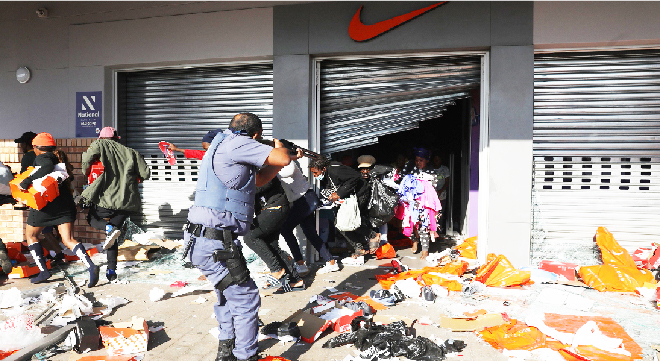The 10 days of unrest in KwaZulu-Natal and parts of Gauteng in July last year wiped out the South African Special Risk Insurance Association’s cumulative retained earnings of more than R8 billion, incoming Sasria chief executive Mpumi Tyikwe said.
In a briefing to Parliament’s Standing Committee on Appropriations this month, Sasria provided a breakdown of how claims developed from Friday, 9 July, to Monday, 19 July.
The most severe (in rand terms) claims were incurred from 11 July (about R6bn) to 14 July (R4.4bn). Claims peaked on day four of the riots – Monday, 12 July – at some R18bn and fell to R5.2bn on day three (13 July).
Tyikwe said Sasria was designed to handle events up to about R17bn.
If the riots had been stopped within three days of their starting, Sasria would have maintained its solvency capital ratio (SCR) and would not have required a capital injection of R22bn from National Treasury, he told MPs.
As was the case when Tyikwe briefed the Select Committee on Finance in April, he said Sasria’s scenario planning assumed the police and the security forces would respond within 48 hours.
Read: Lloyd’s believes it’s likely SA will see repeat of July riots
“Events like [the July unrest] are very difficult to model. This is why the private sector refuses to insure this particular area of the market, and the state has to come in and be the insurer […] However, […] in fairness to Sasria, we have had a 42-year run where we have been right, where we have been able to meet our obligations and pay our policyholders and get businesses going back to work […] What was really different about the July unrest […] was that in our scenario planning […] we never anticipated that the security response will not unfold,” Tyikwe said.
He said Sasria was planning for a scenario similar to what happened last year, and it would engage with Treasury and the government “to say, look, as Sasria this is how far we will be able to go”.
Progress with paying claims
Sasria provided the committee with an update on its progress with settling claims by value band.

By line of business, most claims – 8 205 valued at more than R28.5bn – have been for commercial property, followed by excess of loss, where only 10 claims totalled R4.3bn, and business interruption, with 1 791 claims valued at R2bn.
Sasria has withdrawn its excess of loss cover designed for big companies because the reinsurance premiums were too expensive.

Unrest-related claims were received from 25 urban areas. Most claims, 10 680 valued at more than R22.3bn, were from Durban. It was followed by Joburg, with 2 083 claims valued at R8.4bn, Pietermaritzburg, with 749 claims valued at R717 million, and Pinetown, with 461 claims of R635m.

Tyikwe said that as a result of the R22bn injection from Treasury, Sasria had cash and cash equivalents of R14.5bn, which would assist with meeting its claims.
Loss for the first time in 43 years
For the first time in its 43-year history, Sasria projected it would make a loss of R27.5bn after tax in the year to March 2022.
By contrast, in 2020/21 Sasria made a profit of more than R1.5bn after tax, while its after-tax profit in 2019/20 was R332m.
Tyikwe said Sasria has increased its premiums by an average of 38%, and it expected premium growth of about 40% in the coming year.
The July unrest resulted in Sasria’s loss ratio reaching 1 618.4% in November last year, compared to 22.4% in its 2021 financial year. Before the riots, Sasria’s loss ratio had exceeded 45% only once over the past 10 years, in 2019, when it was 74.7%.
On average, Sasria’s loss ratio was between 35% and 45%. Tyikwe said if Sasria maintained that ratio going forward, it would be able to replenish its reserves and get back to where it was before the unrest in July within five to seven years.
Sasria was facing 20 996 claims valued at some R39bn in 2021/22, compared to 2 976 claims valued at R778m in 2020/21, 4 312 claims valued at R1.2bn in 2019/20, 5 363 claims valued at R1.52bn in 2018/19 and 3 632 claims valued at R739m in 2017/18.
‘Sasria is an economic enabler’
Tyikwe said Sasria’s SCR was -347% in November 2021, which was why the government had to inject the R22bn.
He said the funding would be used only to pay claims and to recapitalise Sasria so it could meet its SCR. The injection would not be used to pay operating expenses.
Tyikwe said that because the state was Sasria’s sole shareholder, Sasria had no other alternative but to ask Treasury for assistance.
He said Sasria was an economic enabler. By Sasria meeting its obligations to policyholders, they were able to reopen their businesses and get their employees back to work and make a profit and pay taxes.
Since Sasria’s 1999 financial year, when it converted to a state-owned company, Sasria has paid tax of more than R4.5bn and dividends of more than R11.1bn, resulting in a total contribution of R15.7bn to the National Revenue Fund.
Sasria’s liabilities stood at R39.5bn: of which R38bn was related to the July unrest: R34.5bn (category insurance) and R3.5bn (wrap cover). It also incurred R1.5bn in claims not related to the unrest.
Its assets of R43.5bn comprised R10bn in assets under management, R9.3bn from reinsurance (category, R6.5bn; wrap, R2.8bn), premiums collected of R2.2bn and Treasury’s equity injection of R22bn.
This meant Sasria had R4bn to augment its SCR.



